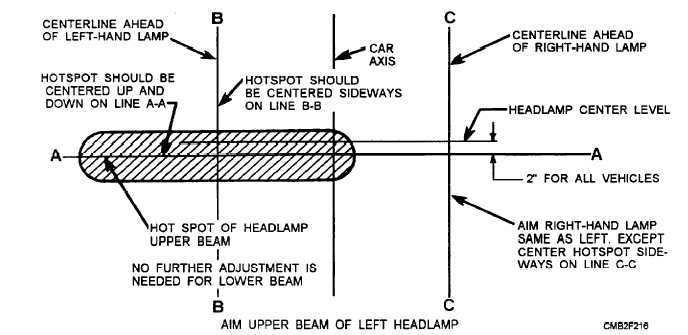In one position, the high beams are turned on, and, in the other position, the dimmer changes them to low beam.
Aiming Headlights
The headlights can be aimed using a mechanical aimer or a wall screen. Either method assures that the headlight beams point in the direction specified by the vehicle manufacturer. Headlights that are aimed too high can blind oncoming vehicles. Headlights that are aimed too low or to one side will reduce the operator's visibility.
To ensure that the headlights are properly aimed, you should have a half a tank of fuel, the correct tire pressure, and only the spare tire and jack in the vehicle. Some manufacturers recommend that someone sit in the operator and passenger seats while aiming the lights.
HEADLIGHT AIMERS are a device for pointing the vehicle headlights in a specified position. They may be permanently installed on a track or may be portable. Some require a level floor, and others have internal leveling mechanisms to allow for uneven shop floors. To use the aimer, follow the instructions for the specific type of equipment.
The HEADLIGHT AIMING SCREEN is a series of measured lines marked on a shop wall or on a framed easel for aiming the headlights of a vehicle. The screen should be no less than 10 feet wide and 42 inches high. When it is mounted on an easel with casters, the screen should be no more than 12 inches from the floor. To comply with regulations of most localities, you should place the screen 25 feet ahead of the vehicle.
The accepted driving beam pattern for passenger vehicles will show the high intensity portion (hotspot) of the light rays centered on a horizontal line that is 2 inches below the center or horizontal reference line on the screen (fig. 2-63). This means that there will be a 2-inch drop of the light beam for every 25 feet of distance from the headlight.
Headlights on large trucks present a special problem because of the effect of a heavy load. At the same 25 feet, truck headlights should be aimed so that none of the high intensity portion of the light will project higher than a level of 5 inches below the center on the headlight being tested. This is necessary to compensate for the variations in loading.
When using a screen for aiming the headlights on a vehicle that uses a four-headlight system, adjust the hotspots of the No. 1 (inboard) lights so that they are centered on the vertical lines 2 inches below the horizontal line (fig. 2-64). The low beam of the No. 2 (outboard) lights is aimed so that the hotspot does not extend to the left of straight ahead or extend more than 6 inches to the right of straight ahead. The top of the hotspot of the No. 2 lights is aimed at the horizontal line. When the No. 2 lights are properly adjusted, the high beam will be correct.

Figure 2-63. - Accepted beam pattern for aiming passenger vehicle headlights.
Continue Reading